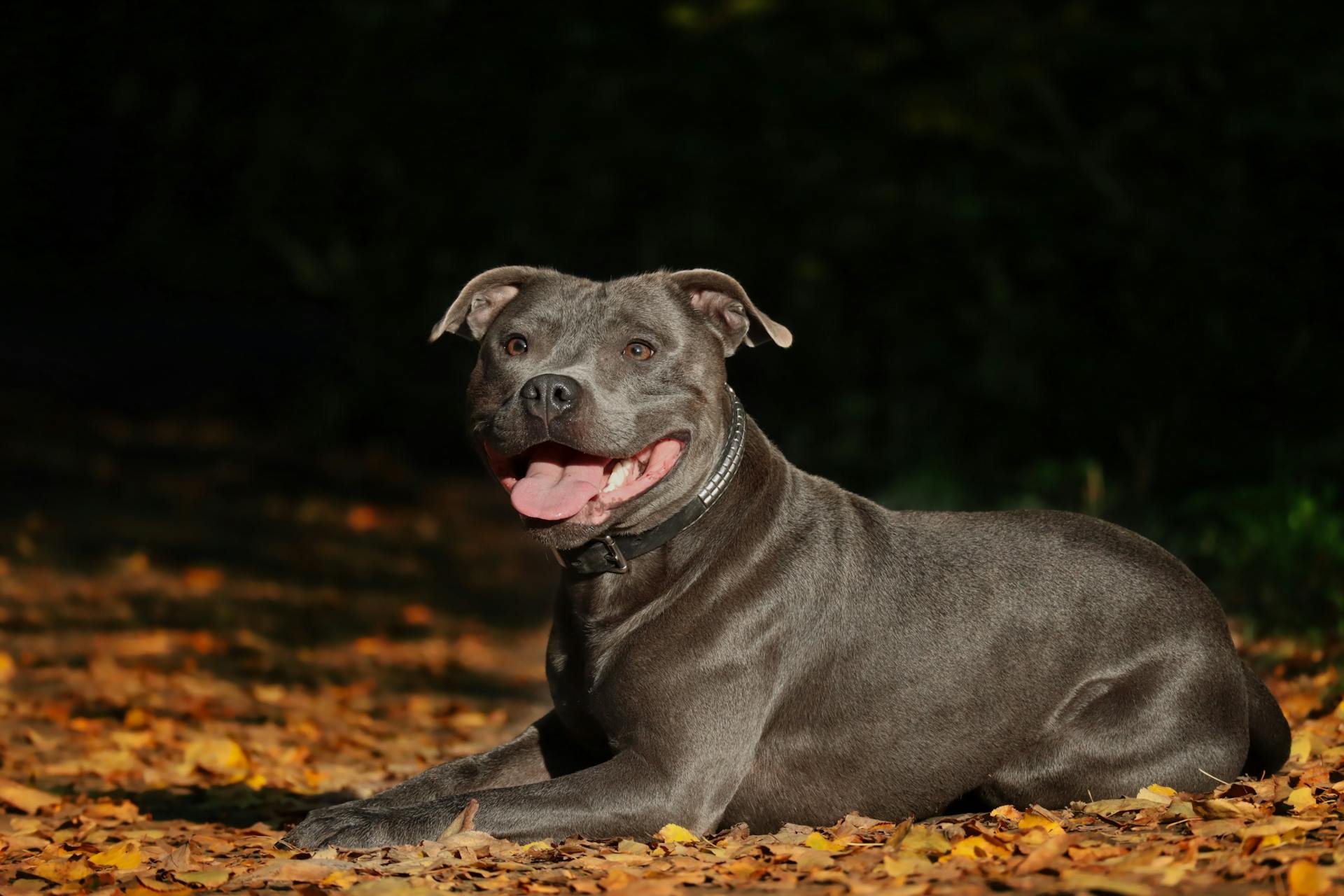
Canine toe cancer can be a challenging and painful condition for dogs. It's a type of skin cancer that affects the toes.
The most common form of canine toe cancer is squamous cell carcinoma. This type of cancer is more common in older dogs.
Dogs with white or light-colored skin on their toes are more prone to developing toe cancer. This is because their skin has less melanin, which offers protection against the sun's UV rays.
Canine toe cancer can cause a range of symptoms, including swelling, redness, and bleeding around the affected toe.
Readers also liked: Most Common Dog Diseases
What Is Foot Cancer?
Foot cancer in dogs is a serious issue, and it's essential to know the facts. One-third of all dogs get cancer, and it's fatal for half of those.
The leading cause of death in older dogs is cancer, specifically in dogs over 10 years old. Early detection and treatment are crucial for a successful outcome.
Foot or toe cancer, also known as digital and soft tissue cancer, can include squamous cell carcinoma, melanoma, osteosarcoma, mast cell tumor, and malignant soft tissue sarcoma. Each of these types of cancer has its own set of signs and treatment.
The main sign of foot or toe cancer is a swelling or ulcer on the foot or toe. If caught early, it's possible that the cancer might be completely contained by amputating the affected toe or foot.
The average cost of treating foot or toe cancer can range from $3,000 to $12,000, with an average cost of $7,500.
Symptoms and Diagnosis
Symptoms of canine toe cancer can be subtle, but it's essential to catch them early. Swelling, soreness, and deformed or missing toenails are common signs.
Dogs may limp or be unable to walk due to the pain, and some may even lose their appetite or weight. A swollen toe or foot can be a sign of squamous cell carcinoma, which is one of the most common types of foot or toe cancer in dogs.
A different take: How Common Is Pyometra in Dogs
Some symptoms of squamous cell carcinoma include a sore or ulceration on the toe that won't heal, a crusted lump on the toe or foot, and a deformed toenail. If you notice any of these symptoms, it's crucial to take your dog to the vet.
Here are some common symptoms of foot or toe cancer in dogs:
- Swollen toe or foot
- Sore or ulceration on toe that will not heal
- Crusted lump on toe/foot
- Deformed toenail
- Pain in foot
- Limping
- Unable to walk
Diagnosis typically involves a combination of tests, including a complete blood count, blood gas, blood chemistry panel, urinalysis, stool sample, fine needle aspiration of swelling or lump, biopsy, and digital radiographs (x-rays) of the affected area and possible areas of spread.
Dog Toe Symptoms & Stages
Dog toe symptoms can be subtle, but they're crucial to catch early. Squamous cell carcinoma, a common type of foot or toe cancer in dogs, can start with a swollen toe or foot, sore or ulceration on the toe that won't heal, or a crusted lump on the toe/foot.
One-third of all dogs get cancer, and it's fatal for half of those. If you notice any of these signs, it's essential to take your dog to the vet right away. Deformed toenails, pain in the foot, limping, or inability to walk are all potential symptoms.
The stages of squamous cell carcinoma in dogs can be determined through tests like radiographs (X-rays), ultrasounds, and analysis of your dog's blood, urine, and lymph nodes. If the cancer has spread, it's called metastasis, and treatment options will depend on how far it's progressed.
Here are some common symptoms of foot or toe cancer in dogs:
- Swollen toe or foot
- Sore or ulceration on toe that will not heal
- Crusted lump on toe/foot
- Deformed toenail
- Pain in foot
- Limping
- Unable to walk
It's essential to be vigilant with your dog's health and grooming to catch these symptoms early. If you notice any changes in your dog's behavior or physical appearance, consult with your veterinarian right away.
How Veterinarians Diagnose
Diagnosing foot or toe cancer in dogs can be a multi-step process. Your veterinarian will likely start with a complete blood count (CBC), blood gas, blood chemistry panel, urinalysis, and stool sample to rule out other health issues.
A fine needle aspiration of the swelling or lump is often necessary to collect a sample of cells. This sample is then examined under a microscope to determine the type of cancer.
Your veterinarian may also take a biopsy, which involves removing a small piece of tissue from the tumor. This provides more detailed information about the cancer.
Additional tests, such as an MRI, CT scan, or ultrasound, may be necessary if the cancer is suspected to have spread.
To make a definitive diagnosis, your veterinarian will examine the squamous cells in the tumor, which can be done through a fine needle aspiration or biopsy.
A fine needle aspiration involves inserting a small needle into the tumor and taking a sample of cells, which are then examined under a microscope.
A biopsy is a more involved procedure, requiring the removal of a small piece of tissue from the tumor.
In some cases, a combination of fine needle aspiration and biopsy may be necessary to confirm the diagnosis.
The following tests may be used to diagnose squamous cell carcinoma in dogs:
- Fine needle aspiration (FNA)
- Biopsy
- Digital radiographs (x-rays) of the affected area and possible areas of spread
Here is a summary of the diagnostic tests used for squamous cell carcinoma in dogs:
- Fine needle aspiration (FNA)
- Biopsy
- Digital radiographs (x-rays)
The choice of diagnostic test will depend on the location and size of the tumor, as well as the veterinarian's professional judgment.
Diagnosis and Stages
Diagnosis of canine toe cancer involves a series of tests, including a complete blood count, blood gas, blood chemistry panel, urinalysis, and stool sample. The veterinarian may also perform a fine needle aspiration of the swelling or lump.
To confirm the diagnosis, a biopsy is typically necessary, which involves removing a small piece of tissue from the tumor. Additional tests, such as digital radiographs (x-rays), may be needed to determine if the cancer has spread to other parts of the body.
Your veterinarian may perform a fine needle aspiration (FNA) or biopsy to collect a sample of cells from the tumor. A biopsy is more involved, as it requires taking a piece of tissue from the tumor to be studied.
The veterinarian may also need to perform tests to determine if the cancer has spread to other parts of the dog's body, particularly if it is present in the toes. This is called staging, and it involves tests such as radiographs (X-rays), ultrasounds, and analysis of the dog's blood, urine, and lymph nodes.
Here's a summary of the common tests used to diagnose and stage canine toe cancer:
- Complete blood count (CBC)
- Blood gas
- Blood chemistry panel
- Urinalysis
- Stool sample
- Fine needle aspiration of swelling or lump
- Biopsy
- Digital radiographs (x-rays) of affected area and possible areas of spread
- Ultrasounds
- Analysis of blood, urine, and lymph nodes
Treatment and Recovery
Surgery is often the most recommended treatment option for canine toe cancer.
Squamous cell carcinoma can be treated by removing the affected area, and in some cases, amputation of the toe, foot, or limb may be necessary if the cancer has metastasized.
Osteosarcoma usually requires surgery to remove the affected toe, and possibly the foot as well.
Mast cell tumors are graded low, intermediate, or high after removal, and may require more tissue or the entire limb being amputated.
Chemotherapy is usually recommended if the grade of the tumor is intermediate or high.
Surgical excision, like amputation of the involved digit, is the treatment of choice for dogs with squamous cell carcinoma.
Margins of at least 2 cm are recommended for surgical excision.
Clinical reports suggest that 95% of dogs who underwent amputation showed a 1-year survival rate.
If the tumors developed in other parts of the digit, the survival time of 1 year was in 60% of the cases.
Consider reading: Canine Liver Cancer Treatment
Excision may be supplemented with radiation and chemotherapy.
For invasive neoplasms, the 1-year survival time is less than 10%.
Cryosurgery and hyperthermia may be helpful for local therapy, especially in early lesions.
Administration of etretinate for 90 days produces total regression of pre-neoplastic lesions.
In dogs treated with controlled localized radio frequency in combination with isotretinoin, better results were achieved.
Using either 5-fluoracil and/or cisplatin for a minimum of 3 weeks produces partial or total regression of the tumors.
Surgery is the treatment of choice if the tumor hasn’t spread to other locations.
The tumor, including the extensions into underlying tissue and bone, are removed en bloc.
Sometimes even part of the jawbone has to be removed.
Surgery is considerably successful if the pet has clean margins.
Dogs function quite well with partial jaws.
Even if surgery isn’t curative, surgery can extend survival.
Radiation therapy is beneficial if the tumor is unresectable, or if surgery can’t remove the tumor completely.
Chemotherapy may be added to therapy, depending on the circumstances.
Melanoma of the skin is typically treated surgically.
It is always recommended to send the tissues that are removed to a veterinary pathologist for histopathology.
Using a microscope, examination of the border between tumor tissue and healthy tissue can indicate whether any cancerous cells have been left behind.
If cells have been left, then a second surgery and/or radiation therapy may be discussed.
Typically, toe melanomas are also treated surgically.
This may include a toe amputation that could involve more than one toe.
If evidence of spread has been found during staging, then the lymph node may be removed as well, and chemotherapy or other therapies may be considered.
Radiation may be considered in cases of digital melanoma when cells have been left behind.
A melanoma vaccine is available, which may be discussed with you in conjunction with the therapies mentioned above.
It is most often used for oral melanomas but may also be used for melanomas on the toes.
This vaccine is not a preventive but trains your dog’s immune system to recognize the melanoma’s proteins as a threat and fight the tumor cells.
Because digital melanoma can cause significant pain, pain medications like NSAIDs (meloxicam, deracoxib, or carprofen) or gabapentin should be considered and discussed with your veterinarian.
Surgery that involves a large tumor or a tumor that has invaded nearby tissue is more invasive, and your veterinarian may need to replace lost skin tissue from another area of the body (skin grafting).
Squamous cell carcinoma on toes may be treated by amputation of the affected digit only.
Amputation of the foot or leg may be recommended in extreme cases for advanced cancer.
A mix of radiation and surgery may be suggested for your pup to ensure all diseased cells are destroyed.
Like radiation, chemotherapy is also unlikely to be suggested on its own and should accompany your dog’s surgery.
Not all dogs will be candidates for surgery.
Some dogs may not be healthy enough to tolerate the anesthesia, or their tumors are inaccessible.
Suggestion: My Dogs Not Eating and Is Lethargic
Radiation, medication, and chemotherapy may be the only option in these situations.
While they may not destroy all cancer cells, they can shrink tumors and prevent further growth.
If your dog’s tumor is caught early, your veterinarian may decide to remove it with cryosurgery.
This involves freezing and destroying the cancer cells with extreme cold.
Another option for the removal of early squamous cell carcinoma is photodynamic therapy.
Photodynamic therapy uses drugs activated by light—known as a photosensitizer or photosensitizing agent—to destroy cancer cells.
Your dog will need to have regular check-ups after surgery to monitor the cancer for any signs that it is coming back.
Recurrence is rare, though dogs with multicentric squamous cell carcinoma may develop new sores after others have been removed.
You can help prevent squamous cell carcinoma by limiting your dog’s exposure
Here's an interesting read: Canine Parvovirus Prevention
Frequently Asked Questions
What does toe cancer look like?
Toe cancer symptoms may appear as brown-black spots on the nail bed, thickening or splitting nails, and painful bumps or nodules under the nail. If you notice any unusual changes to your toenails, it's essential to consult a doctor for proper evaluation and treatment
Sources
- https://wagwalking.com/condition/foot-or-toe-cancer
- https://wearethecure.org/learn-more-about-canine-cancer/canine-cancer-library/squamous-cell-carcinoma/
- https://vcahospitals.com/know-your-pet/squamous-skin-cell-carcinoma-in-dogs
- https://vcahospitals.com/know-your-pet/melanomas-of-the-skin-and-toes
- https://www.petmd.com/dog/conditions/cancer/squamous-cell-carcinoma-scc-dogs
Featured Images: pexels.com


